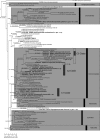Small but Manifold - Hidden Diversity in "Spumella-like Flagellates"
- PMID: 26662881
- PMCID: PMC5066751
- DOI: 10.1111/jeu.12287
Small but Manifold - Hidden Diversity in "Spumella-like Flagellates"
Abstract
Colourless, nonscaled chrysophytes comprise morphologically similar or even indistinguishable flagellates which are important bacterivors in water and soil crucial for ecosystem functioning. However, phylogenetic analyses indicate a multiple origin of such colourless, nonscaled flagellate lineages. These flagellates are often referred to as "Spumella-like flagellates" in ecological and biogeographic studies. Although this denomination reflects an assumed polyphyly, it obscures the phylogenetic and taxonomic diversity of this important flagellate group and, thus, hinders progress in lineage- and taxon-specific ecological surveys. The smallest representatives of colourless chrysophytes have been addressed in very few taxonomic studies although they are among the dominant flagellates in field communities. To overcome the blurred picture and set the field for further investigation in biogeography and ecology of the organisms in question, we studied a set of strains of specifically small, colourless, nonscaled chrysomonad flagellates by means of electron microscopy and molecular analyses. They were isolated by a filtration-acclimatisation approach focusing on flagellates of around 5 μm. We present the phylogenetic position of eight different lineages on both the ordinal and the generic level. Accordingly, we describe the new genera Apoikiospumella, Chromulinospumella, Segregatospumella, Cornospumella and Acrispumella Boenigk et Grossmann n. g. and different species within them.
Keywords: Bacterivorous protists; Chrysomonads; Chrysophyceae; Monas; Stramenopiles; biodiversity; heterotrophic nanoflagellates; microbial food web; microbial loop; taxonomy.
© 2015 The Author(s). Journal of The Journal of Eukaryotic Microbiology published by Wiley Periodicals, Inc. on behalf of International Society of Protistologists.
Figures







References
-
- An, S. S. , Friedl, T. & Hegewald, E. 1999. Phylogenetic relationships of Scenedesmus and Scenedesmus‐like coccoid green algae as inferred from ITS‐2 rDNA sequence comparisons. Plant Biol., 1:418–428.
-
- Andersen, R. A. 2011. Ochromonas moestrupii sp. nov. (Chrysophyceae), a new golden flagellate from Australia. Phycologia, 50:600–607.
-
- Andersen, R. A. , van de Peer, Y. , Potter, D. , Sexton, J. P. , Kawachi, M. & LaJeunesse, T. 1999. Phylogenetic analysis of the SSU rRNA from members of the Chrysophyceae. Protist, 150:71–84. - PubMed
-
- Barth, D. , Kremek, S. , Fokin, S. I. & Berendonk, T. U. 2006. Intraspecific genetic variation in Paramecium revealed by mitochondrial cytochrome c oxidase I sequences. J. Eukaryot. Microb., 53:20–25. - PubMed
-
- Belcher, J. H. & Swale, E. M. F. 1976. Spumella elongata (STOKES) nov.comb., a colourless flagellate from soil. Arch. Protistenkd, 118:215–220.
Publication types
MeSH terms
Associated data
- Actions
- Actions
- Actions
- Actions
- Actions
- Actions
- Actions
- Actions
- Actions
- Actions
- Actions
- Actions
- Actions
- Actions
- Actions
- Actions
- Actions
- Actions
- Actions
- Actions
- Actions
- Actions
- Actions
- Actions
- Actions
- Actions
- Actions
- Actions
- Actions
- Actions
- Actions
- Actions
- Actions
- Actions
- Actions
- Actions
- Actions
- Actions
- Actions
- Actions
- Actions
- Actions
- Actions
- Actions
- Actions
- Actions
- Actions
- Actions
- Actions
- Actions
- Actions
- Actions
- Actions
- Actions
- Actions
- Actions
- Actions
- Actions
- Actions
- Actions
- Actions
- Actions
- Actions
- Actions
- Actions
- Actions
- Actions
- Actions
- Actions
- Actions
- Actions
- Actions
- Actions
- Actions
- Actions
LinkOut - more resources
Full Text Sources
Other Literature Sources
Molecular Biology Databases

